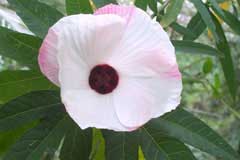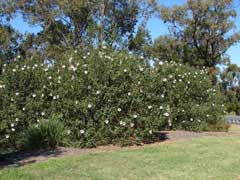 |
|
|
 |
| http://www.flickr.com/people/62938898@N00Hibiscus moscheutos |
Translate this page:
Summary
Physical Characteristics

 Hibiscus heterophyllus is an evergreen Shrub growing to 1.8 m (6ft).
Hibiscus heterophyllus is an evergreen Shrub growing to 1.8 m (6ft).
See above for USDA hardiness. It is hardy to UK zone 10 and is frost tender. It is in leaf all year. The species is hermaphrodite (has both male and female organs) and is pollinated by Insects.
Suitable for: light (sandy), medium (loamy) and heavy (clay) soils and prefers well-drained soil. Suitable pH: mildly acid, neutral and basic (mildly alkaline) soils. It cannot grow in the shade. It prefers moist soil.
UK Hardiness Map
US Hardiness Map
Synonyms
Plant Habitats
Woodland Garden Sunny Edge; Dappled Shade; South Wall. By. West Wall. By.
Edible Uses
Edible Parts: Flowers Leaves Root Shoots
Edible Uses:
Leaves and young shoots - raw or cooked. Pleasantly acid[144, 177, 193]. An excellent spinach substitute, the boiled leaves losing their acidity[193]. Flowers and flower buds - raw or cooked[157]. A very mild flavour[144]. Root - it is edible but very fibrousy[144]. Mucilaginous, without very much flavour[144]. The roots of young plants are used[193].
References More on Edible Uses
Medicinal Uses
Plants For A Future can not take any responsibility for any adverse effects from the use of plants. Always seek advice from a professional before using a plant medicinally.
None known
References More on Medicinal Uses
The Bookshop: Edible Plant Books
Our Latest books on Perennial Plants For Food Forests and Permaculture Gardens in paperback or digital formats.

Edible Tropical Plants
Food Forest Plants for Hotter Conditions: 250+ Plants For Tropical Food Forests & Permaculture Gardens.
More

Edible Temperate Plants
Plants for Your Food Forest: 500 Plants for Temperate Food Forests & Permaculture Gardens.
More

More Books
PFAF have eight books available in paperback and digital formats. Browse the shop for more information.
Shop Now
Other Uses
Fibre
A tough fibre obtained from the stems is used for making nets etc[156, 193].
Special Uses
References More on Other Uses
Cultivation details
Prefers a well-drained humus rich fertile soil in full sun[200]. Suitable for waterside plantings[200]. This species is not very hardy in Britain, it is unlikely to succeed outdoors even in the mildest areas of the country. However, it might be possible to grow it as a half-hardy annual, to flower in its first year from seed.
References Carbon Farming Information and Carbon Sequestration Information
Temperature Converter
Type a value in the Celsius field to convert the value to Fahrenheit:
Fahrenheit:
The PFAF Bookshop
Plants For A Future have a number of books available in paperback and digital form. Book titles include Edible Plants, Edible Perennials, Edible Trees,Edible Shrubs, Woodland Gardening, and Temperate Food Forest Plants. Our new book is Food Forest Plants For Hotter Conditions (Tropical and Sub-Tropical).
Shop Now
Plant Propagation
Seed - sow early spring in a warm greenhouse. Germination is usually fairly rapid. Prick out the seedlings into individual pots when they are large enough to handle. If growing them as annuals, plant them out into their permanent positions in early summer and protect them with a frame or cloche until they are growing away well. If hoping to grow them as perennials, then it is better to grow them on in the greenhouse for their first year and to plant them out in early summer of the following year. Cuttings of half-ripe wood, July/August in a frame. Overwinter them in a warm greenhouse and plant out after the last expected frosts.
Other Names
If available other names are mentioned here
Native Plant Search
Search over 900 plants ideal for food forests and permaculture gardens. Filter to search native plants to your area. The plants selected are the plants in our book 'Plants For Your Food Forest: 500 Plants for Temperate Food Forests and Permaculture Gardens, as well as plants chosen for our forthcoming related books for Tropical/Hot Wet Climates and Mediterranean/Hot Dry Climates. Native Plant Search
Found In
Countries where the plant has been found are listed here if the information is available
Weed Potential
Right plant wrong place. We are currently updating this section.
Please note that a plant may be invasive in one area but may not in your area so it’s worth checking.
Conservation Status
IUCN Red List of Threatened Plants Status :

| Related Plants
|
| Latin Name | Common Name | Habit | Height | Hardiness | Growth | Soil | Shade | Moisture | Edible | Medicinal | Other |
| Hibiscus acetosella | Cranberry Hibiscus | Annual/Perennial | 1.5 |
9-11
| M | LMH | N | M | 3 | 2 | 2 |
| Hibiscus cannabinus | Kenaf, Brown Indianhemp | Annual/Perennial | 1.8 |
6-12
| F | LMH | N | M | 4 | 2 | 3 |
| Hibiscus diversifolius | Swamp Hibiscus | Shrub | 1.0 |
9-11
| | LMH | N | M | 2 | 1 | |
| Hibiscus moscheutos | Swamp Rose Mallow, Crimsoneyed rosemallow, Wild Cotton, Common Rosemallow, Eastern Rosemallow, Swamp | Perennial | 2.5 |
6-9
| M | LMH | SN | M | 1 | 2 | |
| Hibiscus mutabilis | Cotton Rose, Dixie rosemallow | Shrub | 3.0 |
7-10
| | LMH | N | M | 2 | 2 | 1 |
| Hibiscus radiatus | Monarch Rosemallow. Ruby hibiscus, Clavelina | Shrub | 2.0 |
9-11
| M | LMH | SN | M | 2 | 1 | 2 |
| Hibiscus rosa-sinensis | Chinese Hibiscus, Shoeblackplant, Hawaiian Hibiscus, Tropical Hibiscus, China Rose, Rose-of-China, S | Shrub | 2.5 |
9-11
| F | LMH | N | M | 3 | 3 | 3 |
| Hibiscus sabdariffa | Roselle | Annual/Perennial | 3.0 |
9-12
| | LMH | N | M | 3 | 3 | 2 |
| Hibiscus sinosyriacus | Rose Of Sharon | Shrub | 3.0 |
6-9
| M | LMH | SN | M | 4 | 2 | 3 |
| Hibiscus syriacus | Rose Of Sharon, Althaea, Shrub Althea, Hardy Hibiscus | Shrub | 3.0 |
5-9
| M | LMH | SN | M | 4 | 2 | 2 |
| Hibiscus tilliaceus | Beach Hibiscus, Sea Hibiscus | Tree | 8.0 |
10-12
| F | LM | N | DMWe | 2 | 1 | 3 |
| Hibiscus trionum | Flower Of An Hour | Annual/Perennial | 0.6 |
9-11
| F | LMH | N | DM | 2 | 1 | 0 |
| Talipariti tiliaceum | Beach Hibiscus, Sea Hibiscus, Cottontree, Mahoe | Tree | 10.0 |
10-12
| F | LMH | N | MWe | 3 | 2 | 4 |
|
Growth: S = slow M = medium F = fast. Soil: L = light (sandy) M = medium H = heavy (clay). pH: A = acid N = neutral B = basic (alkaline). Shade: F = full shade S = semi-shade N = no shade. Moisture: D = dry M = Moist We = wet Wa = water.

Expert comment
Author
Vent.
Botanical References
200265
Links / References
For a list of references used on this page please go here
Readers comment
| Add a comment |
|
If you have important information about this plant that may help other users please add a comment or link below. Only comments or links that are felt to be directly relevant to a plant will be included. If you think a comment/link or information contained on this page is inaccurate or misleading we would welcome your feedback at [email protected]. If you have questions about a plant please use the Forum on this website as we do not have the resources to answer questions ourselves.
* Please note: the comments by website users are not necessarily those held by PFAF and may give misleading or inaccurate information.
To leave a comment please Register or login here All comments need to be approved so will not appear immediately.
|
Subject : Hibiscus heterophyllus
|
|
|
|